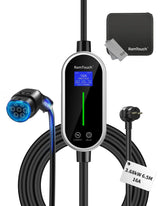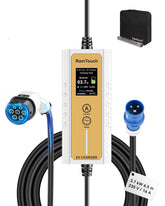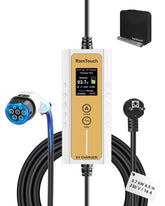Is Your EV Charger Cable Hot? Safe or Dangerous?
Is It Safe If My EV Charger or Cable Feels Hot During Charging?
Understanding Heat, Safety Standards, and Fire Risk in EV Charging
Many EV owners worry when their charging cable or wallbox feels hot during use — especially during high-power 7kW charging sessions. But does warm or even hot-to-touch mean something is wrong?
Let’s break down the facts with reference to IEC safety standards, UL material ratings, and real-world use cases.
🌡️ What’s Considered “Hot”? — Objective vs. Subjective Heat
The feeling of “hot” is subjective — what feels uncomfortable to one person may be perfectly safe according to standards.
🔍 According to IEC Standards:
As defined in IEC 62196-1 and IEC 61851-1, safe surface temperature limits are:
➤ Graspable Parts (e.g., plug handle):
| Material | Max Temp |
|---|---|
| Metal | ≤ 50 °C |
| Plastic/molded | ≤ 60 °C |
➤ Non-Graspable but Accessible Surfaces (e.g., charger body, cable insulation):
| Material | Max Temp |
|---|---|
| Metal | ≤ 60 °C |
| Plastic/rubber | ≤ 85 °C |
💡 Translation: Surfaces that feel “very warm” (around 50–60 °C) are still within the safe range during regular charging.
🔥 Can Heat During Charging Lead to Fire Hazards?
1️⃣ Internal Short Circuit: Is Fire Possible?
If a short circuit occurs inside the charger (e.g., L to N or L to PE), could this lead to fire?
🔥 Fire Prevention by Design:
-
Most EV chargers use V-0 flame retardant enclosures (UL 94 Standard)
-
Self-extinguishing: Any flame must stop within 30s after ignition
-
No flaming drips are allowed during flame exposure
➡️ Even in worst-case faults, the casing will not ignite or spread flames.
2️⃣ Can the EV Cable Overheat or Burn?
Say your charging cable is undersized (e.g., 4 mm² for 32A). Could it melt?
🔌 Cable Safety Materials:
-
EV charging cables typically use TPU (thermoplastic polyurethane) insulation
-
Heat tolerance: 60–100 °C continuous, for 48–168 hours
-
Ignition point: >250 °C — far above normal operating temperatures
Even under heavy 32A loads, TPU cables won’t catch fire in normal usage. However, cable size must match the current — undersized cables will degrade over time.
Real-World Charging: What’s Normal?
During normal use — especially at 7kW (32A, 230V) — it’s completely normal for:
-
The connector head to feel warm or hot
-
The cable body to be noticeably warm, especially near the plug
-
The charger housing to radiate heat (thanks to internal power electronics)
What’s the Real Fire Risk in EV Charging?
It’s not your cable or charger that poses the main fire risk. According to industry data, the top 3 EV charging fire causes are:
-
Improper installation (loose terminals, wrong circuit protection)
-
Damaged or aged power sockets
-
Battery thermal runaway (handled by your EV’s Battery Management System)
💡 Pro Tip: Always use a certified installer and quality-assured chargers and cables.
When Is Heat a Warning Sign?
Stop charging immediately if you notice:
-
Instant burning sensation when touching the plug
-
Plastic deformation, melting, or scorch marks
-
Burning smells near the outlet or plug head
👉 In these cases, contact customer support or an electrician.
📌 Summary: Is It Safe for EV Chargers to Feel Hot?
| 🔍 Scenario | 🔒 Safety Status |
|---|---|
| Connector warm to the touch (≤ 60 °C) | ✅ Normal and expected |
| Cable body mildly hot (≤ 85 °C) | ✅ Within safe limits |
| Abnormal odor, deformation, burning pain | ❌ Stop and investigate |
Frequently Asked Questions (FAQ)
Q1: Is it normal for my EV charger plug to get hot?
A1: Yes, up to 50–60 °C is acceptable and within IEC standards.
Q2: Can my cable catch fire during charging?
A2: No, not under normal use. TPU-insulated EV cables are flame-resistant and designed for 60–100 °C continuous loads.
Q3: How do I check if my charger is overheating?
A3: Watch for strong heat (painful touch), melting plastic, or burnt smell. If in doubt, stop charging.















